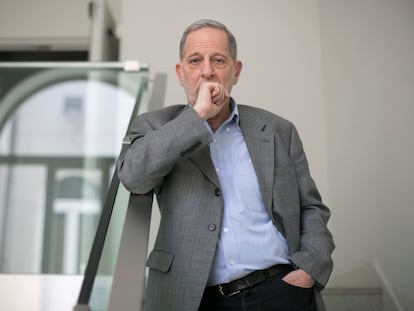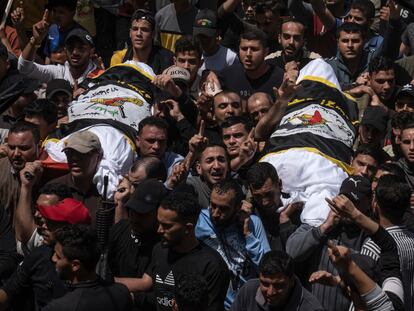Wives, children, neighbors: The other victims of Israel’s airstrikes against militants in Gaza
‘My father used to tell us: ‘I can die at any moment.’ What I could not imagine is that they would also take my mother and my sister,’ says the son of one of the leaders of Palestinian Islamic Jihad killed by a missile
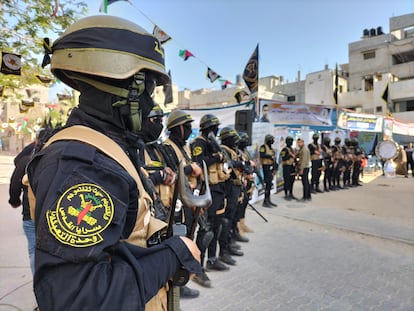
In a house in the Sheikh Radwan neighborhood of Gaza City there hangs a poster paying tribute to “the martyrs,” as those who die in the conflict with Israel are typically called. The youngest members of the group are distributing the usual dates and coffee with cardamom to people who come to offer their condolences.
On a poster showing the faces of Jamal Khaswan and his son Yousef, there are no emblems of Palestinian militias, and no photos of well-known Palestinian leaders such as Yasser Arafat, Ahmed Yasin or Mohammed Dahlan. Instead, there are only three logos: one from the city’s Al Wafa hospital — where the deceased had served as chairman of the board —, another one from a charitable association and a third from a nursing home.
Khaswan’s relationship with Palestine’s armed groups came down to living in the apartment unit right above Tariq Ibrahim Ezzedin, one of three leaders of Palestinian Islamic Jihad against whose homes Israel’s military aviation launched a missile in a series of synchronized selective assassinations, triggering a new escalation of violence and five days of fighting that ended this past Saturday with a ceasefire after 33 deaths in Gaza and two in Israel.
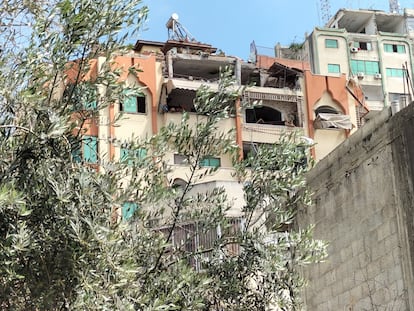
It was 2:00 a.m. when the ceiling collapsed on the bed in which Jamal and his wife, Mervat, were sleeping. Both died, as did their 20-year-old son Yousef, who was sleeping in an adjoining room. Another son, Yasem, who is five years younger, did not find out until the next day, at the hospital, that he had lost three members of his family. The youngest child, a nine-year-old girl, still believes that her parents and one of her brothers “are traveling,” explains Musa Saber Khaswan, Jamal’s brother. They are three of the 14 civilians whose lives were claimed by Israel’s Operation Shield and Arrow, defined this Sunday by Prime Minister Benjamin Netanyahu as “perfect” for having killed ”dozens of terrorists” — including six leaders of the Palestinian Islamic Jihad — and doing so “with total surprise and continuing initiative.”
“I was sleeping and suddenly things fell on my bed. It took me a few minutes to react,” Yasem, who a visible limp from the injuries caused by the falling debris, explains about the moment the missile hit the house. “We live in Gaza and we know that it is a dangerous place, but we never thought it could happen to us, because we know that my family is not a target for Israel,” he says with an absent look in his eyes.
Jamal Khaswan, 53, was a respected figure in Gaza, says his brother Musa Saber, who is four years older. In the 1990s, he studied dentistry and earned a doctoral degree in Russia, and had dual nationality. He was part of the family business of dental prosthetics, which currently employs 10 people and has been run by Musa since his graduation from Tel Aviv University (back when studying in Israel was not a pipe dream for a resident of Gaza). All the children in the family have gone on to study dentistry at college.
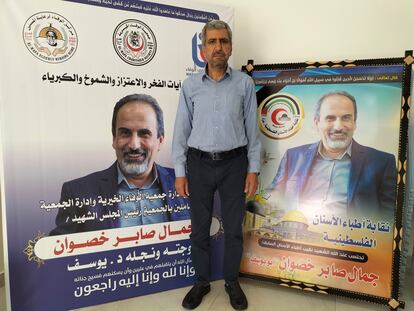
Musa had visited his brother, who also headed the Gaza Dental Association, shortly before the latter’s death. Two hours later, he received a call that the building had been bombed. “It’s a good neighborhood. No one had moved away, no one expected anything to happen. If everyone in Gaza who has a neighbor from Hamas or from Islamic Jihad had to get out, the Israelis would have to start building lots of apartments for us,” he says ironically in one of the rare moments in which his voice does not tremble. “The pain of losing a brother is impossible to explain, but beyond that, the question is: why did he have to die? And I would say the same if I were a Jew or a Christian. And another question, how long will it go on like this?”
Three goals
The gaping holes in the buildings attest to the accuracy of both the impact (the buildings are still standing and, generally, with a single burnt-out apartment) and of Israel’s intelligence information regarding the location of the targets. The missiles were launched at dawn against three bedrooms in three different houses where the leaders of Palestinian Islamic Jihad were resting with their wives and children. Of the 13 deaths caused by that first wave of selective assassinations, on May 9, there were 10 civilians. One of them was five-year-old Hajar, who had snuggled in with her parents in their bed. Her father was Jalil Bahitini, a top commander of the Islamic Jihad.
Another daughter, 10-year-old Nada, has a black eye. That night, she was sleeping on the couch in the family home, just a few meters from the room where the projectile hit. At first, she says, she thought it was a dream. Then she saw a small fire. “I started screaming and realized that no one could hear me because I was under rubble,” she recalls, standing next to her sister Sara, 14. “I was expecting that something might happen to my father. At first, they told me that he had died, but that my mother and sister were only injured,” says Nada, before a lump in her throat prevents her from speaking further.
“My father used to tell us: ‘I could die at any moment,’” says his son Abdelaziz, 17, who was sleeping on the top floor of the two that make up the family home. “Yes, we were worried about him, because we knew he was part of the resistance and because what he said was true. But we thought it could happen in the middle of the street, or in a training field. What I could not imagine is that they would also take my mother and my sister,” he says, standing under the funeral tent where the Islamic Jihad is honoring his father. A group of hooded armed militiamen, the Al-Quds Brigades, are posing while loudspeakers blast nationalist and religious music against the “Zionist enemy.”
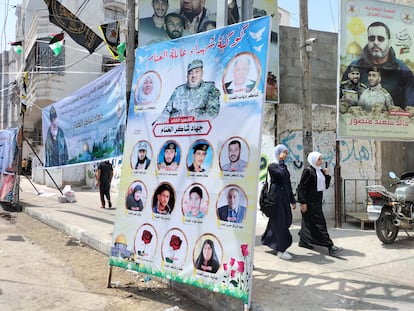
Considered a terrorist group by Israel, the United States and the European Union, the Islamic Jihad — which depends on Iran for weapons and financing — is not very large, but it is particularly combative and Islamist, which is evident in the staging of the tributes to their deceased commanders. There are only men inside the tents, and the dead wives do not typically appear on the posters. The images of their dead leader Tariq Ibrahim Ezzedin extol the warrior in fatigues with the Temple Mount in the background, rather than the father in civilian clothes standing next to his two deceased sons: Ali, eight, and Miar, 12.
Sign up for our weekly newsletter to get more English-language news coverage from EL PAÍS USA Edition
Tu suscripción se está usando en otro dispositivo
¿Quieres añadir otro usuario a tu suscripción?
Si continúas leyendo en este dispositivo, no se podrá leer en el otro.
FlechaTu suscripción se está usando en otro dispositivo y solo puedes acceder a EL PAÍS desde un dispositivo a la vez.
Si quieres compartir tu cuenta, cambia tu suscripción a la modalidad Premium, así podrás añadir otro usuario. Cada uno accederá con su propia cuenta de email, lo que os permitirá personalizar vuestra experiencia en EL PAÍS.
¿Tienes una suscripción de empresa? Accede aquí para contratar más cuentas.
En el caso de no saber quién está usando tu cuenta, te recomendamos cambiar tu contraseña aquí.
Si decides continuar compartiendo tu cuenta, este mensaje se mostrará en tu dispositivo y en el de la otra persona que está usando tu cuenta de forma indefinida, afectando a tu experiencia de lectura. Puedes consultar aquí los términos y condiciones de la suscripción digital.
More information
Archived In
Últimas noticias
Welcome to the post-religion era: The idea of Christianity as the absolute truth has become obsolete
‘I thought you would like it’: The risky sexual practice popularized by TV shows and TikTok
The digitalization of tourism: ‘They promise experiences and gave us the worst possible one’
Mexican peso defies uncertainty with forecasts of a new period of stability in 2026
Most viewed
- Sinaloa Cartel war is taking its toll on Los Chapitos
- Reinhard Genzel, Nobel laureate in physics: ‘One-minute videos will never give you the truth’
- Oona Chaplin: ‘I told James Cameron that I was living in a treehouse and starting a permaculture project with a friend’
- Why the price of coffee has skyrocketed: from Brazilian plantations to specialty coffee houses
- Silver prices are going crazy: This is what’s fueling the rally

